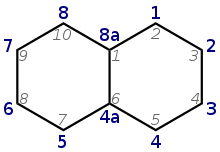Von Baeyer nomenclature
The von Baeyer nomenclature is a system for describing polycyclic hydrocarbons. The system was originally developed in 1900 by Adolf von Baeyer for bicyclic systems[1] and in 1913 expanded by Eduard Buchner and Wilhelm Weigand for tricyclic systems.[2] The system has been adopted and extended by the IUPAC as part of its nomenclature for organic chemistry. The modern version has been extended to cover more cases of compounds including an arbitrary number of cycles, heterocyclic compounds and unsaturated compounds.[3]

Numbered skeletal formula of bicyclo[4.4.0]decane or Decalin. The grey numbers represent numbering according to the von Baeyer nomenclature.
Extended Von Baeyer
gollark: osmarks.net gollarious hypercloud blockchain engineering™ coreutils™ just feed all of `argv` to a GPT-Neo model trained on lots of Linux commands.
gollark: Is "osmarks.net software" a trendy enough name? Maybe it should be "osmarks.net gollarious hypercloud blockchain engineering™ software".
gollark: Anyway, the DreamOS repos should contain *entirely* osmarks.net software.
gollark: ÆÆÆÆÆÆÆÆÆ
gollark: So literally just an install script for Arch?
See also
References
- Adolf Baeyer: Systematik und Nomenclatur bicyclischer Kohlenwasserstoffe.
- E. Buchner, W. Weigand: Bornylen und Diazoessigester [Nebst einer Nomenklatur tricyclischer Kohlenstoff-Ringsysteme nach Adolf von Baeyer].
- Favre, Henri A.; Powell, Warren H., eds. (2013). Nomenclature of Organic Chemistry – IUPAC Recommendation and Preferred names 2013. IUPAC. ISBN 978-0-85404-182-4. Extensive errata to this book has published online as: Moss, G. P. (ed.). "Corrections to Nomenclature of Organic Chemistry. IUPAC Recommendations and Preferred Names 2013". IUPAC.
This article is issued from Wikipedia. The text is licensed under Creative Commons - Attribution - Sharealike. Additional terms may apply for the media files.